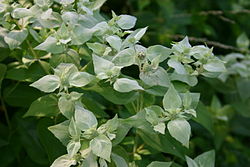| Mountain mints | |
|---|---|
 | |
| Short-toothed mountain mint ( Pycnanthemum muticum ) | |
| Scientific classification | |
| Kingdom: | Plantae |
| Clade: | Tracheophytes |
| Clade: | Angiosperms |
| Clade: | Eudicots |
| Clade: | Asterids |
| Order: | Lamiales |
| Family: | Lamiaceae |
| Subfamily: | Nepetoideae |
| Tribe: | Mentheae |
| Genus: | Pycnanthemum Michx. |
| Synonyms [1] | |
| |
Pycnanthemum is a genus of herbaceous plants in the mint family (Lamiaceae). Species in this genus are often referred to as mountain mints and they often have a minty or thyme-like aroma when crushed. All species of Pycnanthemum are native to the United States and Canada. [1] [2] [3] The center of diversity for the genus is North Carolina with 13 of the 20 species having been collected therein. Nineteen of the 20 species of Pycnanthemum occur in the Eastern US and Canada, and one disjunct species ( P. californicum ) occurs in California and Oregon.
Contents
Pycnanthemum is derived from Greek. The Greek word "pyknos" has the meaning of "dense", "tight", or "close-packed". [4] [5] It was combined with "anthos" meaning flower to give the genus name. [6]
Pycnanthemum belongs to the true mint subtribe (Menthinae), [7] and it has been shown to be closely related to the Monarda , Blephilia , and the scrub mints of the Southeastern United States. [8] Relationships within the genus remain unresolved. A complicated history of polyploidization paired with cryptic morphologies makes this a challenging group for systematists. [9]






